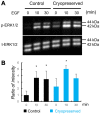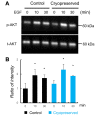Cryopreservation of Biologically Functional Submandibular Gland Rudiments from Fetal Mice
- PMID: 33144433
- PMCID: PMC7811606
- DOI: 10.21873/invivo.12164
Cryopreservation of Biologically Functional Submandibular Gland Rudiments from Fetal Mice
Abstract
Background/aim: Cryopreservation of cell lines has been widely used in the laboratory; however, cryopreservation of organs is still considered to be difficult. The submandibular gland (SMG) of fetal mice is one of the best-characterized organs. We investigated the conditions for cryopreserving SMG rudiments.
Materials and methods: Embryonic day 13 SMG rudiments were cryopreserved with or without a cryoprotectant. They were thawed and incubated in DMEM/F12 medium. Moreover, the influence of EGF stimulation on the signaling cascade after frozen-thawing the rudiments was analyzed by Western blotting.
Results: When SMG rudiments were cryopreserved without a cryoprotectant, all cells in the rudiments died. However, the SMG rudiments that had been preserved in a cryoprotectant showed branching morphogenesis. Additionally, the responsiveness of signaling cascades to EGF did not differ between frozen with a cryoprotectant and non-frozen rudiments.
Conclusion: Cryopreservation might be a useful technology for preserving tissues from small organs, such as fetal SMG rudiments.
Keywords: AKT; Cryopreservation; EGF; ERK1/2; branching morphogenesis; submandibular gland.
Copyright© 2020, International Institute of Anticancer Research (Dr. George J. Delinasios), All rights reserved.
Conflict of interest statement
The Authors have no conflicts of interest to declare regarding this study.
Figures




References
-
- Rapats G, Luyet B. Patterns of ice formation in aqueous solutions of glycerol. Biodynamica. 1966;10(198):1–68. - PubMed
MeSH terms
LinkOut - more resources
Full Text Sources
Miscellaneous
